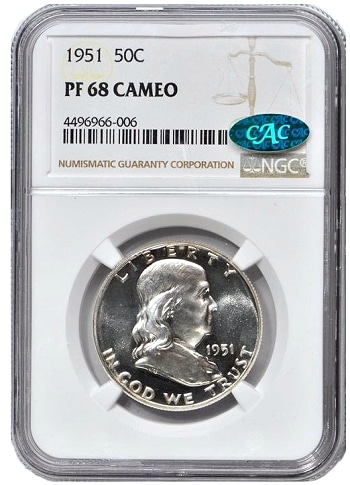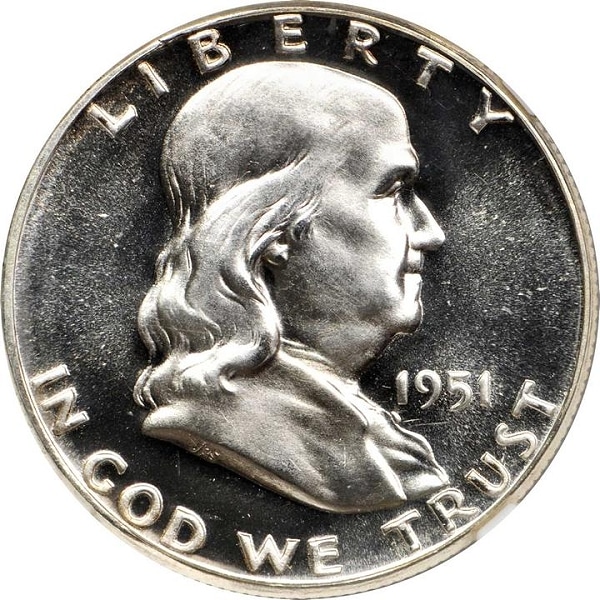The 1951 Franklin Half Dollar Proof was a second-year Proof issue struck at the Philadelphia Mint and represents a challenging issue for collectors looking to complete this popular 20th-century half dollar series.
Replacing the Walking Liberty half dollar in 1948, the Franklin half dollar obverse was designed by United States Mint Chief Engraver John R. Sinnock, and the reverse was created by Sinnock and future Chief Engraver Gilroy Roberts. The series was in production from 1948 to 1963 at the Philadelphia, Denver, and San Francisco Mints for business strikes and at the Philadelphia Mint from 1950 to 1963 for Proofs. No Proof Sets were issued by the Mint in 1948 or 1949, the first two years of production for the Franklin half dollar series.
Before Proof Set production was suspended at the outset of the United States’ entry into World War II, the popularity of the coin collecting hobby was in ascendance. From 1940 to 1942, demand for Proof Sets nearly doubled, from 11,246 to 21,120 sets. When the sets returned in 1950, demand had increased to 51,386 sets. The 1951 set saw a modest increase in mintage, but by 1953, demand for annual Proof sets exceeded 120,000 sets. By the end of the Franklin half dollar series’ run, sales would exceed three million sets annually.
The quality of coins and the sophistication of the Mint’s packaging increased as the series advanced. Given that issues struck from 1954 to 1963 remain affordable in most grades, the Franklin series remains popular and approachable for collectors at all levels.
Still, the 1950 and 1951 Proof Sets hold a special place due to their scarcity and the market’s insatiable need for quality pieces.
How Much is the 1951 Franklin Half Dollar Proof Worth?
The 1950 Franklin half dollar will always be considered the key date from this short-series 14-year run of Proofs, but the 1951, with a mintage of just 6,114 more examples, should be considered a close second.
 From a quality standpoint, the typical 1951 Proof was better made than the 1950, with the Mint polishing the Proof dies of this issue more frequently than they did in 1950. Cameos and Deep (or Ultra) Cameos remain elusive, however.
From a quality standpoint, the typical 1951 Proof was better made than the 1950, with the Mint polishing the Proof dies of this issue more frequently than they did in 1950. Cameos and Deep (or Ultra) Cameos remain elusive, however.
Taking a look at the current (as of October 2021) NGC and PCGS population data reveals a few interesting pieces of information. Both services show that the preponderance of coins graded fall in the Proof 64 to Proof 66 range, with the percentage of coins grading 66 declining 34% from the numbers grading 65 at PCGS, and down 20% by way of the same comparison at NGC. At PCGS, 1951 Franklin half dollars are readily available at the Proof 67 level; more so at NGC. Scarce are examples in Proof 68. This is where PCGS tops out, with just 11 grading events reported. NGC has recorded 49 grading events at this level and just one at Proof 69.
We have not mentioned Cameo and Deep (Ultra) Cameo coins. The production of coins with blast white Cameo frost was incidental to the process of striking Proofs and because of this, collector expectation should be that the preponderance of all Proof strikings of Franklin half dollars from this era will come with fully brilliant surfaces. The population of Cameo and Deep (Ultra) Cameo coins reflects this fact.
At PCGS, coins designated Cameo represent just 8% of the total coins graded for the issue. Deep Cameo coins represent an even lower number, 1.5%. At NGC, Cameos represent 11.2% of the total graded population, with Ultra Cameo coins coming in at 2.48% of the total.
The dichotomy of the Cameo / Deep (Ultra) Cameo situation is this: those that wish to be into a Gem-quality coin for $650 to $1,000 will settle for a Cameo – preferably a nice “tweener” that could be seen as marginally deep. Those with $2,500 to $7,500 to spare can reach for the deepest, thickest frosting they can find. Personally, the coin would have to be over-the-top with “white swan on a black lake” contrast to justify the price differential, and a number of strong Cameos would make mediocre Deep (Ultra) Cameos if reconsidered.
In their brilliant Gem form, 1951 Proofs are affordable and range between $350 and $600, typically. There are a sufficient number of coins in holders to date to make this a fair market price in today’s dollars for the issue. We caution against buying raw examples blindly, but we believe that well-preserved Proof sets of the period should yield a coin that is at least in the 64-66 range. Getting a grade higher than this will prove difficult because the abrasive nature of the plastic sleeve and the age of the plastic will likely have impacted the surfaces of the coins contained within.
Furthermore, given the financial upside, it’s doubtful that a knowledgeable seller would give someone much of a break on a raw example unless they have already surmised that the coin is a dog. Be duly diligent before making a purchase and factor in your own cost of certification if you must put your 1951 Proof Franklin half dollar in a slab.

Design
It is interesting to note that both the obverse and reverse designs of the Franklin half dollar were rejected by the Commission of Fine Arts (CFA). The Treasury ignored this recommendation and approved the design anyway. In this instance, it seems that the CFA got it wrong. Despite its simplicity, the Franklin half dollar design has become an iconic exemplar of U.S. modern coinage, with the coin’s frosted cameo Proof strikings being among the most striking 20th-century coins produced by the United States Mint. These examples are highly coveted by collectors.
Obverse:
John Sinnock designed both sides of Franklin half dollar. His obverse design was based on Jean Antoine Houdon’s 18th-century bust of Founding Father Benjamin Franklin. The date appears in the lower-right of the obverse, while “IN GOD WE TRUST” curves beneath Franklin and “LIBERTY” curves around the top above Franklin.
Reverse:
Sinnock and Gilroy Roberts designed the reverse, which depicts the Liberty Bell and a small eagle (which was mandated by law) at right.
“UNITED STATES OF AMERICA” arcs above the Liberty Bell while the denomination, “HALF DOLLAR” curves beneath it. “E PLURIBUS UNUM” appears to the left of the bell and an eagle, its wings spread, stands to its right. Two sets of three parallel horizontal lines encircle the base and bottom of the bell, for circulation strikes, this is a key grading diagnostic indicative of strike quality.
Franklin half dollars struck at the Philadelphia Mint were not struck with a mintmark.
Edge:
The edge of the Proof 1951 Franklin half dollar is reeded.
Designers
From 1925 through 1947, John R. Sinnock was the Chief Engraver of the United States Mint. He is best known for the designs of the Roosevelt dime and the Franklin half dollar.
Gilroy Roberts was the ninth Chief Engraver of the U.S. Mint, serving from 1948-1965. He is best remembered for his design of the Kennedy half dollar obverse.
Coin Specifications
| Country: | United States |
| Year Of Issue: | 1951 |
| Denomination: | 50 Cents |
| Mint Mark: | None (Philadelphia) |
| Mintage: | 57,500 |
| Alloy: | 90% Silver, 10% Copper |
| Weight: | 12.50 g |
| Diameter: | 30.60 mm |
| Edge | Reeded |
| OBV Designer | John R. Sinnock |
| REV Designer | John R. Sinnock | Gilroy Roberts |
| Quality: | Proof |
* * *






Just my opinion but Sinnock represents the death of beautiful American coinage. His designs spelled the death of such iconic designs as the Walking Liberty Half, the Buffalo nickel, Liberty Quarter, Mercury dime and the Indian head cent. Our coins went from being beautiful works of art to dull and dreary.
Agree and nothing much has changed for far too long. Like so much else in America even who’s on the coinage has become politicized. We can do better than this.
No matter how well loved or honored our past Presidents are, they do not belong on regular circulating coins. Commemorative coins would be fine but our nation’s coinage should be:
“An allegorical figure representative of Liberty on the obverse and the bald eagle symbol of our country on the reverse.”
Just as it was from the beginning of our coinage until one by one each denomination lost that unique American look.
On the minor coinage where an eagle would be too small, then a wreath, torch, shield or other appropriate item as was used before.